Both she and the client thought maybe that the problem was some kind of an overspray of chemicals by both the homeowner and landscaper. Luckily this was not the case, it was much more benign that that.
The tree was actually hurting itself. If you have ever grown Citrus you know that many of them have thorns.....Kind of like this:
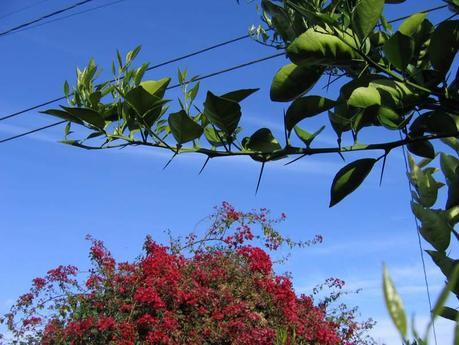
Pretty evil looking huh?
Well, what was happening was, every time the wind started to blow it would knock the fruit against these thorns. As you can see, they are very sharp. The resulting damage will then look like this:
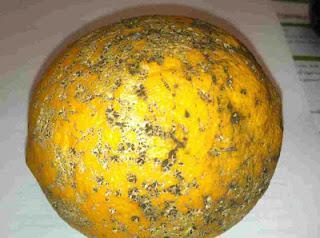
and this:
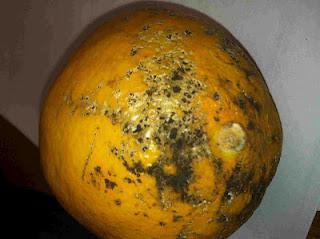
For the most part, this is just a cosmetic damage. If you are planning on eating the fruit in a short period of time, there should be no problem. The interior is usually unaffected.
However, if you are planning on storing your fruit for any length of time or want to ship it to a friend, this is where there could be problems. Those little puncture wounds, numerous in many cases, are entry points for an array of bacteria and fungi.
Let's check a few of these out.
We will start with the most colorful, Green and Blue Molds.
Green mold, the most important of these two post-harvest diseases, is caused by the fungus Penicillium digitatum. A rapid breakdown occurs in fruit punctured or bruised during harvesting and packing operations. The fungus enters the fruit through wounds. Therefore, the disease can occur on fruit on the tree, in the packinghouse, in transit, in storage and in the marketplace. A white mold is first seen growing on the peel. The mold later turns green because of the large number of green spores produced. Decayed fruit becomes soft and shrinks.
Blue mold, Penicillium italicum is less common than green mold, but the blue mold grows faster. Both infections develop in damaged areas in the rind.
If you see something along these lines, then you know there was probably some kind of damage:
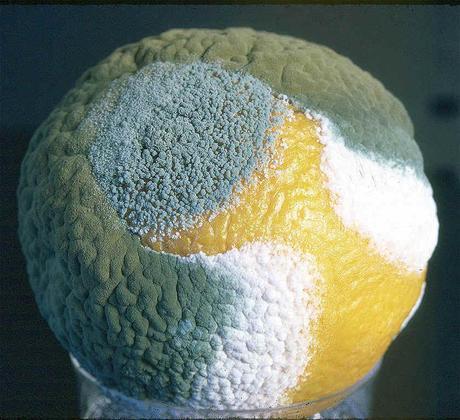
I think this was a science project from my 5th grade class, if not it should have been.
Another post harvest problem can be, Diplodia Fruit rot caused by the fungus Diplodia natalensis. This infection occurs most frequently at the stem end of the fruit but occasionally can occur via injuries on the side of the fruit. The fungus grows rapidly through the spongy central axis of the fruit. It grows unevenly through the rind, which produces finger-like projections of brown tissue on the infected fruit.
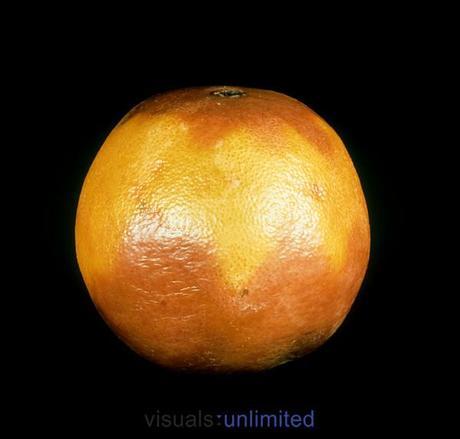 Photo courtesy of visualsunlimited
Photo courtesy of visualsunlimitedSo as you can see damaged Citrus peel can be a nasty problem. There are a couple of easy ways to fix it.
You can snip off those thorns with a pair of toenail clippers. I know this sounds like a long and tedious task, and it is, but the fruit will thank you and anything else that happens to bump up against the tree will thank you. You do not necessarily need to do the entire tree, just where there is fruit.
Thinning the branches of the tree to open it up more is something else that can be done. This is actually a good suggestion anyway, it allows more airflow into the tree which will cut down on the possibility of other diseases.
You can plant buffers by your Citrus trees to help cut down on the wind or plant them in non windy areas. Shielding your trees from the wind is probably the easiest to do. Yes, you can cut off the thorns, but small stubby branches can do the same kind of damage.
Something that many people don't think of when harvesting Citrus. You really should snip the fruit from the tree instead of pulling. This can lead to a problem of the peel leaving a little button on the tree and the fruit is then susceptible to all of those nasty problems I mentioned above.
I should mention one other puncturing type of problem. This one also happens semi-frequently and there not many ways to stop it from happening.....our feathered friends can become a nuisance. I actually watched a Mocking Bird do this before I could scare him off.

Thankfully this was just a one time attack and I have not had a problem since. Maybe he didn't like it, or maybe me yelling at him like an old man yelling at a bunch of kids in his yard did it.
So, in a nutshell, protecting your harvest should be your number one priority. You have fed, watered, pampered and protected your tree to get some glorious fruit...wouldn't it be a shame if a gust of wind ruined all those months of hard work?
Happy Growing!
Darren

